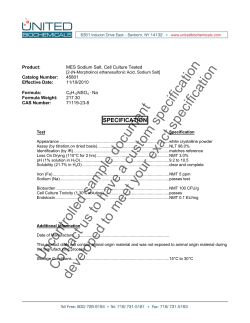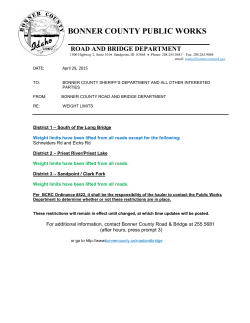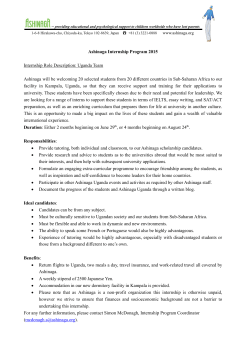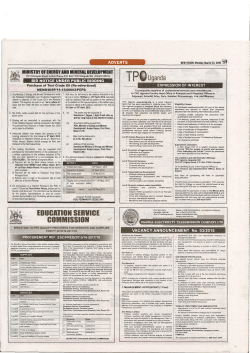
Kampala NMT Policy - Centre for Science and Environment
REPUBLIC OF UGANDA Dialogue of the South on Clean Air and Sustainable Mobility Centre for Science and Environment (CSE) New Delhi April 6 – 10, 2015 Uganda’s Non-Motorised Transport Policy Benon Kajuna, Commissioner, Policy and Planning, Ministry of Works and Transport Mission and Objectives Burkina Faso: tricycles for Walking and bicycling persons are healthy, sustainable, economical and disadvantaged non-polluting means of transport: the citizens of Uganda have the right to walk and cycle in safety, while conforming to appropriate regulations, in their pursuit of work and family tasks and in accessing social and economic activities and services. The primary objectives of the NMT policy is to increase the recognition of NMT as one of the key transport modes and to integrate NMT as an essential element of public transport by providing safe NMT infrastructure and allocating adequate and sustainable funding for the development and promotion of NMT. Universal design Universal Design refers to pedestrian and transport infrastructure, facilities and services designed for the widest range of potential users, including people with mobility and visual impairments (disabilities), the elderly, those in wheelchairs and people walking with small children or with pushchairs. While aiming to address the needs of people with disabilities, Universal Design is a comprehensive concept with provisions that can benefit all users. Universal design: non-compliant NMT infrastructure Kampala, Uganda Pedestrian crossing on northern bypass with no ramp and inappropriately placed as leading into a culvert Universal design: non-compliant NMT infrastructure Kampala, Uganda Open cross drain Universal design: non-compliant NMT infrastructure Kampala, Uganda Unprotected dangerous drop Universal design Government will require that appropriate ‘Universal Design’ principles are applied in all new and refurbished NMT transport infrastructure. Existing NMT infrastructure that is non-compliant will gradually be retrofitted to ‘Universal Design’ principles. Emphasis will be on priority areas where obstructions and drops cause problems to pedestrians and those using wheelchairs and 'disabled' tricycles. Roads and road maintenance Government recognises the importance to people and economy of Uganda of walking and the use of non-motorised transport. The Government will ensure that the needs of pedestrians and bicyclists will be adequately addressed in the planning, implementation, regulation and enforcement of roads and other rural and urban infrastructure. Roads and road maintenance Government recognises that a great contribution to the safety of pedestrians and bicyclists in Uganda would be made if all rural and urban roads were maintained to their designated standards. Government expects the relevant authorities to improve road maintenance. Roads and road maintenance Government recognises the need to maintain footways and cycleways as well as the roads. This must not only include physical repair and maintenance, but also regular operational maintenance, involving clearing away obstructions, debris and any encroachment. Hierarchy of presumed rights Government considers that all road users in Uganda have rights to use the road but they also have clear responsibilities and must not abuse their rights. Dangerous road use is unacceptable. All road users must be empathetic to the needs of others, giving way when appropriate and not unreasonably demanding priority. Government will promote this through education and awareness creation, coordinated by the National Road Safety Agency. Safety The Government will promote the safety of pedestrians and nonmotorised transport through the National Road Safety Authority (NRSA). NRSA will be expected to work with the Ministry of Education to improve road safety education and awareness in schools and educational establishments. Safety Government will promote the stricter enforcement of safety-related legislation for all road users. This will include dangerous driving practices by motorists and motorcyclists and the obstruction of pedestrian footways by cars, motorcycles and traders. Safety The Government will promote the construction of new NMT infrastructure, including footways, cycleways and cycle lanes, particularly in areas of high risk to pedestrians and bicyclists. Safety The Government will promote improved maintenance on all roads in order to remove some of the main causes of accidents. Gender Bicycles can empower women but men own most means of transport. Gender Government recognises that men and women have equal rights to own and use bicycles. Gender discrimination should be actively discouraged. Government will consult on gender related practices and attitudes and the social and economic implications of women using bicycles prior to initiating culturally appropriate promotion of bicycle use by women National roads Government, through the MoWT and the roads authorities, will review existing standards and prepare relevant codes and manuals that encompass the infrastructure requirements of Government, through the MoWT and the roads authorities, will pedestrians and bicyclists and the best practices to be followed review existing standards and prepare relevant codes and from design to implementation. manuals that encompass the infrastructure requirements of pedestrians and bicyclists and the best practices to be followed from design to implementation. National roads Government will require that all national road designs, and related infrastructure such as bridges, should include a non-motorised transport statement explaining how the needs of pedestrians and cyclists have been incorporated into the designs. This should include a statement as to the adequacy of the hard shoulder width close to trading centres. Urban roads No infrastructure for pedestrians Uganda Urban roads ‘Chaotic’ roads Urban roads Government will require the authorities responsible for urban roads to identify priority areas for retro-fitting NMT infrastructure, including covered drains, constructed footways and designated shoulders. The use of one-way routes should be considered, to allow greater allocation of space for NMT users. Urban roads Government proposes that all new and refurbished urban roads in Uganda should provide appropriate NMT infrastructure, with footways and bicycle lanes. Urban roads Government requires that all urban road designs should include a non-motorised transport statement explaining how the needs of pedestrians and cyclists have been incorporated into the designs. Government requires that all relevant construction and maintenance contracts should require a non-motorised transport statement explaining how the needs of pedestrians and cyclists should be incorporated into the works. Urban footways Urban footways Use of bollards Urban footways Government requires urban authorities to regularly inspect and maintain footways and enforce regulations to keep them unobstructed. Where there is a problem with vehicle encroachment, bollards should be used to protect the pedestrians and the footways Government intends that the safe space available to NMT users will be substantially increased through the consistent enforcement of existing regulations to prevent the encroachment of road shoulders and footways by construction materials, stationary vehicles and informal trading enterprises. Government will require the urban authorities and the relevant enforcement personnel to achieve this. Pedestrian crossings Design Visibility Platforms Signs Islands Signals Traffic calming Location Pedestrian crossings Pedestrian crossings Guidelines Enforcement Publicity and education Cycleways Government will commission studies to identify appropriate cycle routes (green ways) and cycle networks in and around Kampala and other towns. Government will work with KCCA and other urban authorities to develop demonstration and pilot projects that prioritise cyclists Bicycle parking Tanzania Very few facilities for parking bicycles safely Bicycle parking Government will require that suitable stands for easy and secure bicycle parking should be included in the standards for all major buildings noting that cycle parking should be conveniently located for accessing the relevant building or facility. Such stands should UK normally be closer than the car parking spaces. Footbridges Kampala, Uganda Non-integrated infrastructure. No access for pedestians to the road crossing the bridge which could be used as a footbridge over the busy road) Footbridges Government requires the provision of adequate safe crossing facilities for pedestrians and NMT users on busy or dangerous national and urban roads, noting the benefits to pedestrians of level crossings provided there is adequate safety, compliance and enforcement. Where traffic and pedestrian consideration require provision of footbridges, these will, as far as practicable, incorporate Universal Design principles. Pedestrianisation Government encourages urban authorities to develop NMT master plans that provide for cycle networks and appropriate pedestrianisation and one-way systems. Transport integration BRT Funding and financialand issues Government intends that planning for the needs of pedestrians and bicyclists will be an integral part of all land transport schemes, including transport terminals and BRT. All BRT stops will incorporate Universal Design for easy pedestrian access and provide adequate bicycle parking facilities. Feeder bicycle routes will be developed. District and Community Roads On District and Community Roads the level of traffic makes it relatively easy for pedestrians, bicyclists and motorised traffic to ‘share the road’ District and Community Roads For the benefit of NMT and all road users, Government recommends that on District and Community roads, particular attention should be given to the adequate maintenance of road shoulders and drainage systems. District and Community Roads Government will require that all relevant construction and maintenance contracts should require a non-motorised transport statement explaining how the needs of pedestrians and cyclists should be incorporated into the works. Government will require compliance with these requirements. Rural footpaths and trails Government is aware of the great importance of rural footpaths to the people and economy of Uganda. Through its decentralised administrations and rural development projects, it will promote community-based action to consider the importance and condition of rural footpaths and to plan and implement appropriate maintenance and improvement interventions on priority paths. Rural footbridges Government will commission a review of rural footbridges, covering existing provision, additional requirements and recent experiences from other countries. If the conclusions suggest rural access is being constrained by the lack of good footbridges, Government will consider the creation of a specialised footbridge unit within the Ministry of Works and Transport. Regulation and enforcement Government will require KCCA and other urban authorities to enforce regulations to prevent the encroachment of NMT infrastructure by traders, parked cars and other obstructions. Regulation and enforcement The Government recognises the contribution that motorcycle boda-bodas make to the overall public transport system in the country, but requires them to conform to regulations relating to safety and the rights of other people, including pedestrians and bicyclists Legislation Government is commissioning a review the Transport and Road Safety Act and the Highway Code and will ensure that both adequately address the needs of pedestrians and bicyclists Education and training Government will promote the importance of walking, bicycling and the safety of all road users through appropriate educational curricula, training, awareness raising and advocacy. The Ministry of Education, the NRSA and other statutory bodies will help children and adults to understand existing regulations and the importance of responsible, empathetic behaviour of pedestrians, bicyclists and drivers of motor vehicles. Government will promote greater understanding of the Highway Code and encourage cycling proficiency courses and tests. Thank you for your attention
© Copyright 2025









